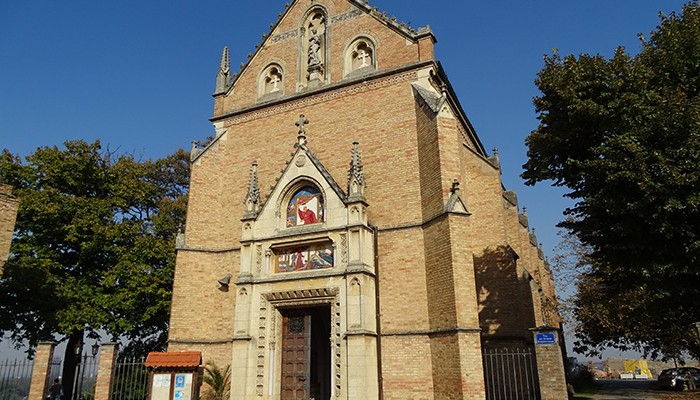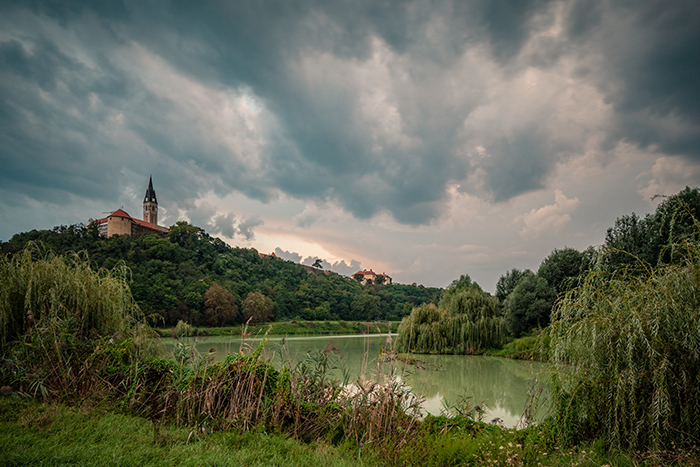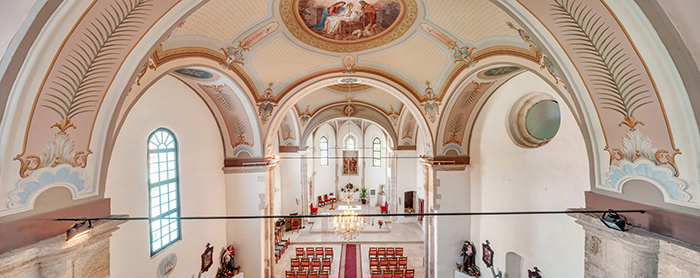
These are the places of special energy and spirituality. Syrmian churches, small churches and chapels in the fields, on the slopes above Danube, in the villages, simply call for contemplation. You will enjoy their beauties, stories and legends
Almost unknown to general public and they say that Our Lady heals there. What Lourdes is for France, Ilok is for Syrmia. The humble Slavonians and Syrmians do not make a show of it, they pray peacefully since 1865 when on the place of today’s chapel suddenly a spring and later that night the figure of Our Lady appeared. From that day the spring is known as „Our Lady’s water“.
Almost unknown to general public and they say that Our Lady heals there. What Lourdes is for France, Ilok is for Syrmia. The humble Slavonians and Syrmians do not make a show of it, they pray peacefully since 1865 when on the place of today’s chapel suddenly a spring and later that night the figure of Our Lady appeared. From that day the spring is known as „Our Lady’s water“.
Placed where peace gets its sense
If you travel towards Ilok you should stop in picturesque village Bapska. Around a kilometre and a half from the settlement on the cemetery, in almost forgotten medieval settlement Baba, your attraction will be drawn by one of the most beautiful Romanic churches of Syrmia and Slavonia. Built in the 13th century, on the verge of the plain that goes steep towards the water spring (also known as “Our Lady’s well) it had many upgrades and alterations throughout the century. Miraculous painting of the Holy Virgin Mary of the unknown author, which they call Lady of Bapska here, is especially worshipped on the feast of Nativity of the Blessed Virgin Mary on September 8. From the church to “Our Lady’s well”, which has always been considered miraculous, leads a nicely arranged the Way of the Cross.
In search of places of special energy and peace you have to visit Nijemci. On the hill in the middle of the centre of this peaceful Syrmian village dominates the church of St. Catherine which was built in the 14th century. The archaeologists claim that on the spot of the present gothic church with elements of baroque and valuable late-baroque inventory used to be a small Romanic church. Under present floor there were two more floor levels discovered, in the right corner in front of the apse there are traces of Roman architecture, and during excavation graves in a row from the Bijelo brdo culture were discovered. During the Ottoman time Nijemci was the centre of kadiluk, which is proven by remains of the architecture in the park beneath the church, which is elevated on locality of the former medieval Gradina with preserved trench.
Not far away from Nijemci, in Lipovci, there is especially nice church of St. Lucas – Lučica. On the feast of Nativity of the Blessed Virgin Mary many members of folklore ensembles pilgrimage in their folk costumes, and it is an attractive sight even to those who are not that fond of folklore. Built on an artificial island on the branch of the Spačva river, the church of St. Lucas or popularly called Our Lady Lučička kept the most original gothic features in the area of the Vukovar-Srijem county. It was named after a painting, which is lost, of St. Lucas painting the picture of Mother of God. They say that originally there was a Templars monastery, then Franciscan monastery which was destroyed after the arrival of the Ottomans. The church was renovated a couple of times in th 19th century, and it got its today’s appearance during the time of the bishop Strossmayer.
Three monasteries you have to visit
On the foundation of the old church and monastery from the 11th century, Ivan Morovićki, governor of Mačva, who was a ruler of Šarengrad in the 15th century, built a new church and monastery to Franciscans. They did not leave it even during the Ottoman occupation. The church of St. Peter and Paul is originally gothic, expanded in the baroque time, its tower is extremely valuable monument, and in the last decade it has been under severe conservationist oversight due to renovation of baroque frescas in the church. It is interesting that the monastery in Šarengrad is the only preserved medieval monastery in Croatia.
The church and monastery of St. John of Capistrano create a well-known view of Ilok. It used to be dedicated to Mother of God taken to Heaven, but today is this church from the 14th century dedicated to St. John of Capistrano. The tower in the monastery where the saint used to live is one of the most beautiful viewpoints in Ilok, and within the church there is a memorial chapel where he suffered and died in 1456. After the Ottomans left, the church and the monastery got their baroque elements, and in the beginning of the 20th century the renovation was entrusted to Herman Bolle who introduced the last stylistic changes in neogothic style, just like those he used in Zagreb cathedral.
It does not matter if the church and Franciscan monastery of St. Philip and Jacob are in Slavonian or Syrmian part of Vukovar. The journeys know no limits, so if you happen to be in this town you cannot miss this beautiful sacral building located on one of the best places above Danube. It was completely destroyed during the Homeland war; it got its old shine and rich cultural and historical heritage is integrated in tourist offer of the town of Vukovar. Relics of St. Bono, Franciscan museum Vukovar, crypt of the Eltz counts, rich library, monastery wine cellar and the most beautiful in Vukovar – are additional reasons why you have to visit this place of piece and spirituality. The church and monastery were built in 1732 thanks to generous donations of the Eltz family, and the construction lasted nine years. After the cathedrals in Đakovo and Zagreb, the church of St. Philip and Jacob is the third longest in Croatia.
One was a Roman soldier, the other was a nobleman and judge
Maybe you did not know that Vukovar and Ilok have their own saints? Known as children’s protector, St. Bono was first Roman soldier and Christian persecutor, then after he had met the Pope Stephen I he was baptized and ordained. As a worshiper of Christian God, he was thrown to dungeon and executed martyred on August 1, 260 in Rome. His relics were, with approval of the Pope Benedict XIV brought on Drava and Danube on June 24, 1754 to Vukovar, and on that day people celebrate the festival of St. Bono. During the Homeland war they were taken from the altar of St. Joseph and transferred to the crypt of the old part of church of St. Philip and Jacob, where they stayed until they were burnt in 1995. The hidden wrist of his hand was found in the ruins and it kept in a silver sarcophagus in the renewed church.
The saint of Ilok – John of Capistrano was born in 1386 in a nobleman’s family in Italian town of Capistrano. He was an excellent law student, city judge, even city administrator. In a political turnover it cost him dungeon, and after that he decided to change his lifestyle. He was ordained in 1415, on feast day of S. Francis, and two years later he became a priest and an excellent folk preacher. He travelled through Spain, the then Germany, Austria, Czech Republic, Hungary and in 1465 in Belgrade, in the eve of the battle against the Ottomans he saw a fire arrow in the sky and that moment he knew that Christian army, which was outnumbered, would win the Ottomans. He died in Ilok in the same year on October 23, and that day is now celebrated as the festival of St. John of Capistrano. His relics disappeared from in 1526 and were never found.


